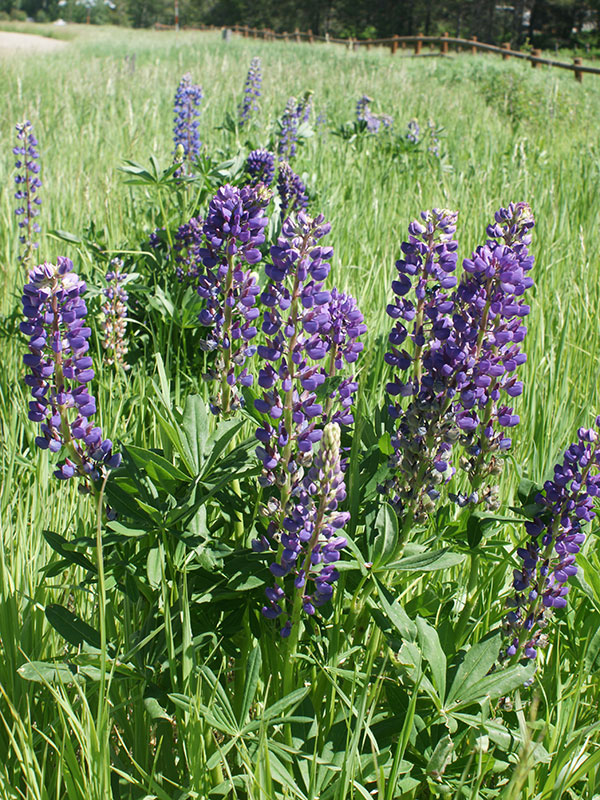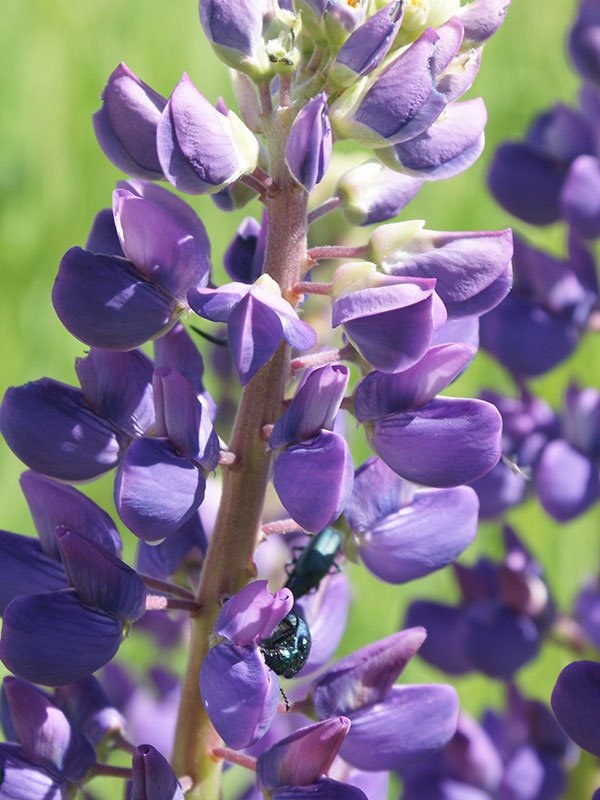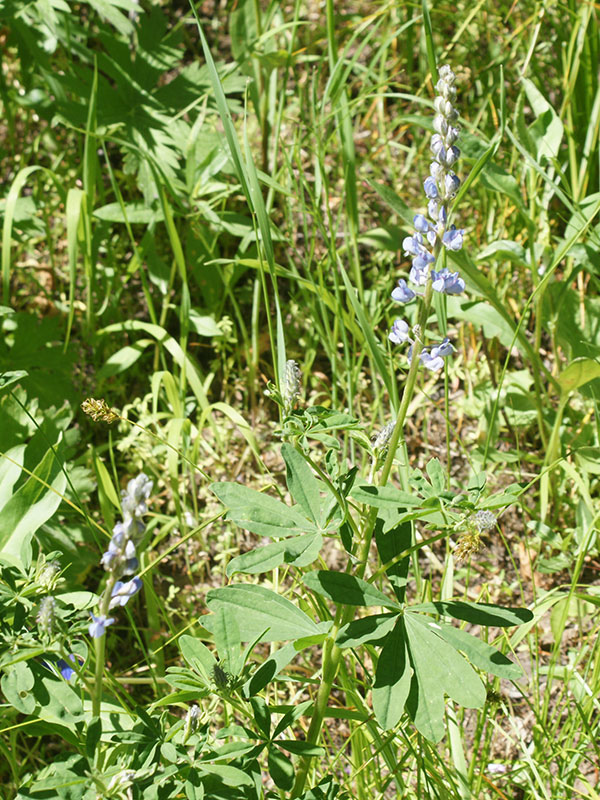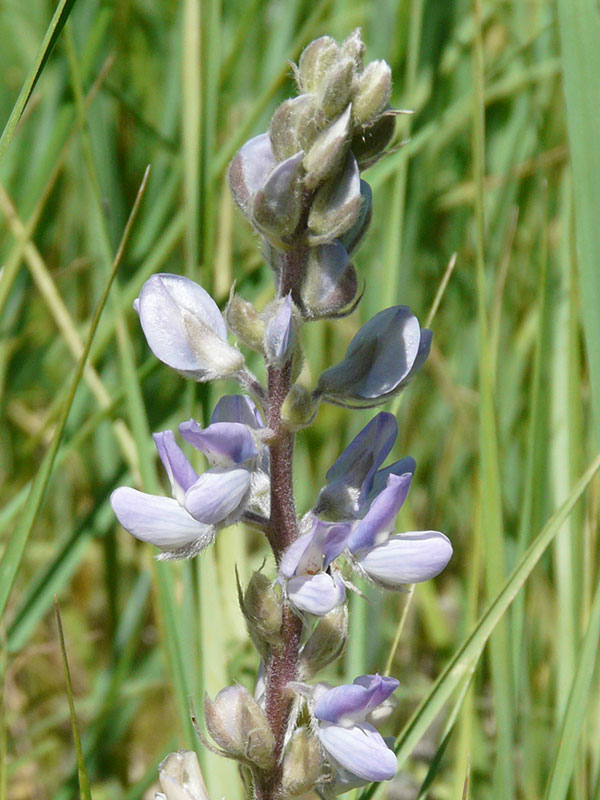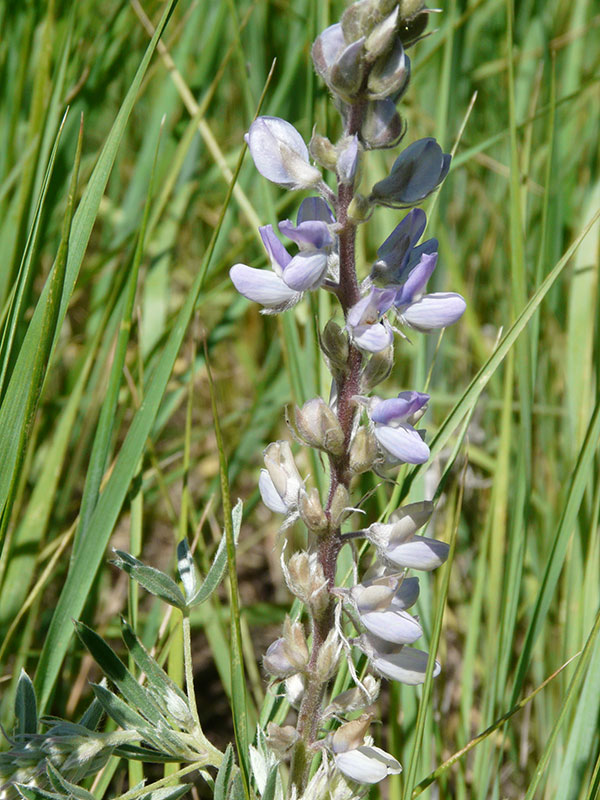Lupinus spp. / silvery and silky lupins
- palmately compound, usually silvery-green leaves
- 5-9 leaflets per leaf; long petioles
- flowers on long, spikey racemes, blooming from bottom upward
- numerous flowers, but all rather teeny; most purple or blue
- flowers are above the leaves
- seeds in short, hairy pods
At the outset, it is important to stress that taxonomy of the lupins is quite messy. By and large the problem is that there are no clear diagnostic features. That is certainly true of two major species in the Valley – L. argenteus (silver) and L. sericeus (silky). Dee Stickler in his Alpine Wildflowers description says that L. argenteus alone has had 50 different Latin names. There are also such high levels of sexual compatibility that fertile hybrids form easily, messing up the taxonomy even more. And of course, as with many other species on this site, there are several different varieties of each of the species.
Although the photos in the gallery may make it look easy to distinguish silvery and silky lupins, Earle and Lundin leave the difference at this: A major difference between silvery and silky lupins is that the leaves of the silvery are less hairy, in general, than those of the silky. That isn’t much. “Usually” figures heavily in all the descriptions of the species, as does “tend to”. Thus, silky tends to have more rounded leaflets. The banner (larger upper petal) is usually hairy on the back with a white center. The flower clusters of silky lupins tend to be looser and lower, well into the leaf canopy, and they tend to be smaller. Silvery lupins may grow to higher elevations, but the overlap in ranges is extreme.
For that reason, I hesitate to say I can tell the difference. Even if I actually believe the assignments to species in the gallery, I would not feel confident with the next plant I saw.
So, to go beyond the fact that lupins generically are pretty easily learned and recognized… the flowers of the lupins are borne in racemes, spike-like but with each flower on a short pedicel and the individuals blooming from the bottom upward. Each inflorescence has many flowers, each rather teeny (1/4-1/2 inch long); most are purple or blue. The flower clusters are above the leaves, more so in the case of L. argenteus.
In each flower, the banner (the uppermost component of the flower) is white at the center, hairless, and noticeably bent backwards. The reddish stalks and bracts often have a dense covering of long white hairs, but they can also be virtually hairless. There are exceptions to all of this, and none of it is particularly striking in the gallery photos.
As for the vegetative parts of the plant, expect at least a few branched stems, either covered with hairs or not. The plants can be up to 5 feet tall, although 1-2 feet is most common (silky lupins tend to be shorter, perhaps). The leaves are palmately compound and silvery-green (depending on how hairy they are). Silky lupins are putatively more hairy on the bottom sides than on the tops. Each leaf has 5-9 leaflets. The petioles on the upper leaves are as long as the leaves, but on the lower leaves may be considerably longer. This may be an adaptation to maximize light absorption.
The seeds are borne in hairy pods. Seed set seems to be variable to low in the Valley, meaning there are lots of empty pods.
Lupins in general are poorly represented in the seed bank. Instead, they are perennial from a well-branched, woody crown (caudex), and spread quickly to form colonies.
Both of these species are drought tolerant and adapted to rocky soils. That allows them to be found in most habitats throughout the Valley. Their overall size depends on moisture availability and soil fertility. Under “good” conditions, they can grow and spread quite well.
Lupins are quite interesting with respect to their mineral metabolism, especially that of nitrogen and phosphorous. Like other legumes, lupins form symbiotic associations with Rhizobium spp. bacteria, leading to the formation of root nodules where atmospheric nitrogen is converted to inorganic forms useable by the plants. For this reason, lupin seeds are often included in land reclamation mixes even though the plants themselves – including the seeds – are toxic to cattle (and humans).
Lupins also generally do not participate in symbiotic relationships with fungi, a relationship known as mycorrhizae. Given that that relationship is associated with much improved acquisition of phosphorous, that raises the interesting question of how the plants adapt otherwise to low P. The answer, in part, is that under phosphorus deficient conditions, lupins form cluster roots (a.k.a. proteoid roots) that exude various organic acids (citrate, malate, oxalate etc.) into the soil, the effect of which is solubilization of phosphate.

And finally, of course, there is always Dennis Moore…
| Color | |
|---|---|
| Family | |
| Blossom size | |
| Inflorescence size | |
| Inflorescence type | |
| When? | |
| Where? |
